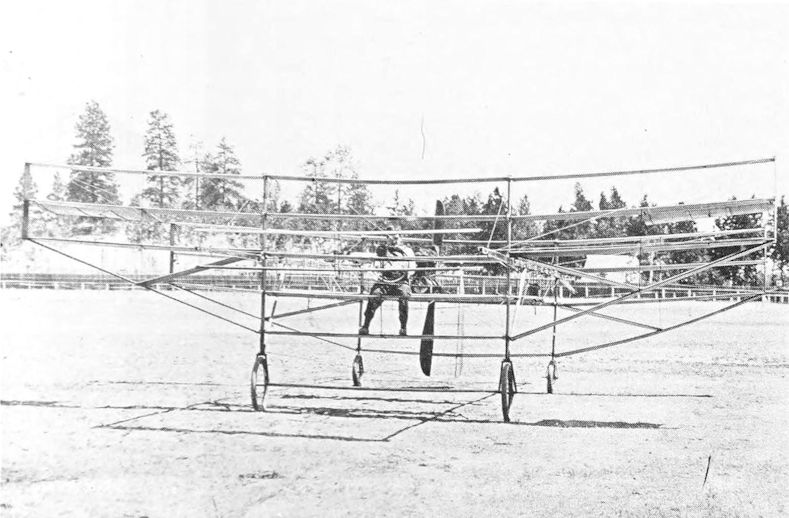
Описание
Страна: Канада
Год: 1911
K.Molson, H.Taylor Canadian Aircraft since 1909 (Putnam)
Gibson Multi-plane
Following the crash of the Twinplane, Gibson resolved to build another aircraft. Although he used the same engine and some parts from the Twinplane, to pay for the new machine he had to sell his house.
The new design retained much of his original concept and used the four-wheel undercarriage with the engine mounted approximately centrally between the wheels but this time driving a single pusher propeller.
The design change was in the wings and control system. Gibson had read Sir Hiram S. Maxim’s Artificial and Natural Flight and became convinced of the value of high aspect ratio wings. So for the tandem monoplane wings of the Twinplane he substituted two sets of very narrow triplane wings (Gibson was quoted as saying ‘None of the lifting parts are over 12in (30cm) in width’), and the forward elevator was altered to a narrow-chord biplane structure. Ailerons were placed on the outer ends of the centre plane of the front set of wings. The pilot’s controls now consisted of foot pedals to operate the rudder, and a wheel to operate the ailerons when rotated and the elevators when moved fore and aft.
The Multi-plane was built at Ladner, near Victoria, on the ranch of British Columbia’s Lt-Governor Pattison, and $10,000 was reported to have been spent on its construction. It was shown at a Made-in-Canada Fair at Vancouver on 8-14 June, 1911. Its exhibition was the responsibility of Jack Woods who was associated with Gibson but whose role in the construction of the machine is not known. At the Fair, Gibson met Alexander M. Jaap of Forest, Ontario, and he joined Gibson in his experiments. The aircraft was then shipped to Kamloops, British Columbia, where it was exhibited again, and between the two exhibitions some modifications were made to the rear undercarriage.
The Multi-plane was then shipped to Calgary and taken by horse to Jack Hayes’ ranch about three miles north of the city. It was reported that, beginning early in July, the Multi-plane made a number of successful short flights, with Jaap at the controls as Gibson had promised his wife that he would not fly.
The most successful flight was the last on 11 August, 1911, and the Calgary Herald reported it as follows: ‘While attempting to make a landing from a height of over 100 feet in the air - Alex Jaap - crashed down into a swampy coulee - and narrowly escaped death. His machine was badly wrecked. Jaap, who had flown about a mile in a test flight, miscalculated the ground on which he proposed to descend, and when within 50 feet of the earth noticed that the turf was honeycombed with badger holes. He attempted to ascend - but it was tod late. His engine had stopped and refused to start again. His only chance - was to drop obliquely into the swampy ground of a nearby coulee. When the machine swooped down into the soft soil the wheels stuck in the mud and the terrific momentum literally tore the aeroplane to pieces. Had it not been for the unusual construction of the machine the motor would have fallen upon him [Jaap] and crushed his life out. As it was he escaped with a few bruises.’
After the accident Gibson announced that he would ‘rebuild my machine with pressed steel plates’ which he was going to have made in Toronto. It was also reported that when rebuilt it would be flown by P. Julien Chatel, a Calgary man who was stated to have worked with Louis Bleriot in France. The machine was never rebuilt.
Thanks to the efforts of the well-known Canadian aviation historian, the late Frank H. Ellis, the Gibson engine, Canada’s first aviation engine, was located and is now in the National Aeronautical Collection at Ottawa.
One 40 hp Gibson engine. Empty weight 700 lb (318 kg). No other information available.
- K.Molson, H.Taylor Canadian Aircraft since 1909 (Putnam)
Фотографии
-
K.Molson, H.Taylor - Canadian Aircraft since 1909 /Putnam/
The Gibson Multi-plane from the front, probably at Kamloops, British Columbia.
-
K.Molson, H.Taylor - Canadian Aircraft since 1909 /Putnam/
The Gibson Multi-plane viewed from the rear on exhibition at Vancouver. W. W. Gibson is at the right in a bowler hat. In this view the aircraft has twin rear wheels


